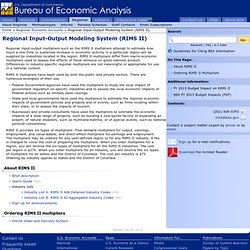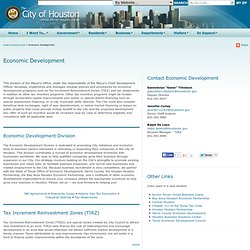

U.S. Bureau of Economic Analysis (BEA) Texas Emerging Technology Fund. “In Texas, we understand that high-tech companies don't just happen overnight but are a product of forethought, sound vision and planning, and strategic investments by both the public and private sectors.

Through our Emerging Technology Fund, we are bringing the best scientists and researchers to Texas, attracting high-tech jobs and helping start-up companies get off the ground faster.” -- Gov. Rick Perry FY2013 Annual Report to the Texas State Legislature on the Texas Emerging Technology Fund.FY2013 Annual Report Summary. What is the Texas Emerging Technology Fund? The Texas Emerging Technology Fund (TETF) was created by the 79th Texas Legislature in 2005 at the urging of Gov. TETF grants are awarded in the following three areas: Welcome to U.S. Cluster Mapping Website. Texas BioAlliance. Rice Alliance. CPRIT. Regional Input-Output Modeling System (RIMS II) Regional input-output multipliers such as the RIMS II multipliers attempt to estimate how much a one-time or sustained increase in economic activity in a particular region will be supplied by industries located in the region.

RIMS II multipliers differ from macro-economic multipliers used to assess the effects of fiscal stimulus on gross national product. Differences in industry-specific regional multipliers are not meaningful or appropriate for use in a national context. RIMS II multipliers have been used by both the public and private sectors. There are numerous examples of their use. Federal Government agencies have used the multipliers to study the local impact of government regulation on specific industries and to assess the local economic impacts of Federal actions such as military base closings.
RIMS II provides six types of multipliers: final-demand multipliers for output, earnings, employment, and value added; and direct-effect multipliers for earnings and employment. BIOHOUSTON. BCC. The Biotechnology Commercialization Center (BCC), located in the University Center Tower (UCT) at UTHealth, is available for new startup companies.

The BCC’s mission is to help commercialize and incubate UTHealth and Houston-based technologies, while increasing the number of Texas-based companies. Located within the heart of the Texas Medical Center, the BCC provides valuable access to information, collaboration and expertise. Ammenities include: • Approximately 15,000+ sq. ft of combined laboratory, office, and shared areas on three adjacent floors in UCT dedicated to startup companies • Access to UTHealth core laboratory and animal services as well as capital equipment • Conference and meeting spaces • Shared building services • Onsite Parking. Economic Development.
This division of the Mayor's Office, under the responsibility of the Mayor's Chief Development Officer, develops, implements and manages citywide policies and procedures for economic development programs such as Tax Increment Reinvestment Zones (TIRZ) and tax abatements in addition to other tax incentive programs.

Other tax incentive programs might be funded through accelerated capital improvements plan action or special district financing such as special assessment financing, or in-city municipal utility districts. The City could also consider beneficial land exchanges, right of way abandonment, or below-market financing or leases on public property that could provide mutual benefit to the City and the proposed development. Any offer of such an incentive would be reviewed case-by-case to determine eligibility and compliance with all applicable laws.
Economic Development Division 380 Agreements • Enterprise Zones • Historic Site Tax Exemption • Industrial Districts • Tax Abatements. BioScience Research Collaborative.